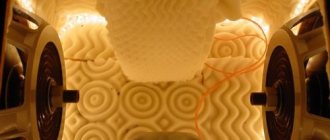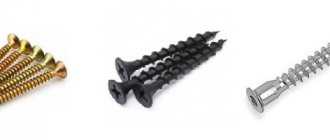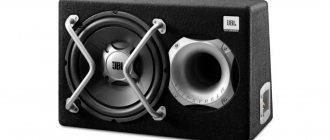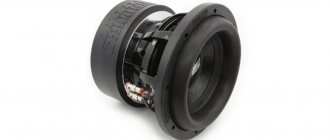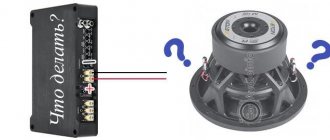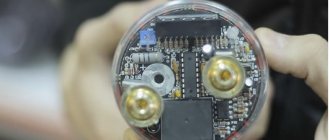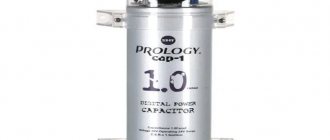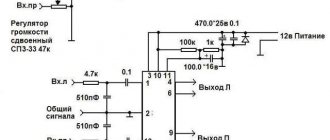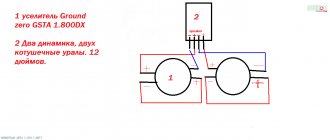Choice of acoustic design: ZY, FI or HF.
Free or Free-air
Pros: -Good cooling of the subwoofer coil due to the absence of a housing -Does not require a housing, which saves space in the car -Structured bass, fast, without lag Cons: -Low efficiency (the quietest design) -Difficulty in making a shelf. __________________________________________________________________________________ ZY or Closed Box
Pros: -Easy to calculate and manufacture -Does not require a large volume, which saves space in the car -Structured bass, fast, without lag Cons: -Low efficiency -Poor cooling of the subwoofer coil due to the absence of any holes in the housing
__________________________________________________________________________________ FI or Bass reflex
Pros: -High efficiency (louder than ZY) -Good cooling of the subwoofer coil -Ability to customize the design for certain genres of music in order to obtain maximum efficiency in a certain low-frequency band Cons: -Difficult to calculate -Takes up much more space than ZY -Has more blurry bass, unlike ZY (By the way, the quality of bass in FI can still be improved, but by sacrificing pressure) ___________________________________________________________________________________ HF or Quarter-wave resonator
Pros: -Highest efficiency (louder than FI and much louder than ZY) -Fast, without lag, bass -Not such a pronounced hump as FI, which gives an increase in volume over a larger frequency band Cons: -Difficulty in setting up the amplifier in order to avoid mechanical damage to the subwoofer - Certain requirements for the subwoofer (presence of a long-throw moving system, low quality factor) - Huge size - Requirements for increased control of the amplifier due to insufficient damping of the subwoofer with this design - Lack of the ability to use amplifiers that exceed the RMS power of the subwoofer by more than twice
Here we will look at the three main types of boxes (boxes) used in subwoofers (as well as in other speakers). But first, a little about the purpose and function of any box. The acoustic head emits sound not only “forward” but also backward, while the front and rear sound waves are opposite in phase. In this regard, there is a term “acoustic closure”, in which the waves on both sides of the diffuser add up and (if they are opposite in phase) cancel each other out. In this case, ideally you will not hear anything at all, but in practice the sound will be very far from the original. The acoustic system box allows you to eliminate this short circuit and give the sound the required characteristics in terms of power and frequency.
Closed box (ZY) – sealed box
This is the easiest type of acoustic design for speakers to manufacture. The vibrations in such a box are in a closed volume and are eventually damped. But since a sound wave is energy, when it decays it turns into heat. And although the amount of this heat is small, it still affects the characteristics of the acoustic system. (warmer air expands and increases the rigidity of the system). To prevent this effect, the core is filled from the inside with sound-absorbing material, which, while absorbing sound, also absorbs heat. The increase in air temperature becomes much smaller and it “seems” to the dynamics that there is a significantly larger volume behind it than in reality. In practice, in this way it is possible to increase the “acoustic” volume of the box compared to the geometric one by 15-20%.
Despite the simplicity of this design, it has many advantages.
- Firstly, the ease of calculating characteristics. There is only one parameter here - volume.
- Secondly, throughout the entire frequency range, vibrations of the diffuser are restrained by the elastic reaction of the air volume. This significantly reduces the likelihood of speaker overload and mechanical damage. I don’t know how comforting this sounds, but for avid bass lovers, the speakers in closed boxes sometimes burn, but almost never “spit out”.
- Thirdly, with the right choice of head parameters and volume for it, a closed box has no equal in the field of impulse characteristics, which largely determine the subjective perception of bass notes.
If everything is so good, why are all the other types of boxes needed? There is only one catch. K.P.P. In a closed box it is the smallest compared to any other type of acoustic design. Moreover, the smaller we manage to make the volume of the box, while maintaining the same operating frequency range, the less effective it will be. There is no more insatiable creature in terms of power input than a closed box of small volume, which is why the speakers in them, as was said, although they do not spit out, they often burn.
conclusions
We have long gotten used to the idea that a subwoofer is an integral part of a cinema system. The debate about its role in the Hi-Fi system has not subsided for quite some time. The lucky ones who have a properly configured triphonic or “2+2” system tirelessly try to convince others that “life has become better, life has become more fun.” Unfortunately, very often it is to no avail.
For my part, I can add: after I once heard a well-tuned triphonic, most speakers for me became not so attractive in the low-frequency range. Many of them need subwoofer support - and this is audible to the naked ear. But the choice, as always, is yours.
Bass reflex (FI) – vented box
A bass reflex is the next most common type of acoustic design. In a bass reflex, part of the energy that is “put against the wall” in a closed box is used for peaceful purposes. To do this, the internal volume of the box communicates with the surrounding space through a tunnel containing a certain mass of air. The size of this mass is chosen in such a way that, in combination with the elasticity of the air inside the box, it creates a second oscillatory system that receives energy from the back side of the diffuser and radiates it where needed and in phase with the radiation of the diffuser. This effect is achieved in a not very wide frequency range, from one to two octaves, but the efficiency is within its limits. increases significantly.
Which material is better
What is the best way to make a subwoofer box?
In principle, there are many materials from which a housing for such a speaker can be made. It can be plywood, MDF, chipboard and so on. Each of these materials has not only advantages, but also disadvantages.
Note. The best material for making a subwoofer enclosure, according to many experts, is shipboard laminated plywood.
Finding ship plywood is not as difficult as it seems at first glance. Construction sites and other manufacturing enterprises have such material. Formwork is often made from this plywood. This material is always moisture resistant, very durable and tough. In a word, for a subwoofer body this is what you need.
Note. It will be useful to know that in the West, where the manufacture of homemade enclosures for subwoofers is highly encouraged, they prefer MDF. They don’t have any marine plywood at all, and many experts see this as the reason for their love for MDF.
Chipboard is also a good material, but it doesn’t like moisture at all. In addition, when processed, chipboard tends to crumble. On the other hand, if you take thicker material, the problem can be solved.
What to make a subwoofer box from
Some experts also recommend other materials, but they are, as a rule, not so popular - for example, glued laminated boards.
What is the best material to make a subwoofer box from?
Band pass loudspeaker
The third type of subwoofer, quite often used in car installations (although less often than the previous two) is a bandpass speaker. If a closed box and a bass reflex are acoustic high-pass filters, then a band-pass filter, as the name implies, combines high- and low-pass filters. The simplest bandpass loudspeaker is a single 4th order (single vented). It consists of a closed volume, the so-called. rear chamber and a second one, equipped with a tunnel, like a conventional bass reflex (front chamber). The speaker is installed in the partition between the chambers so that both sides of the diffuser operate in completely or partially closed volumes - hence the term “symmetrical load”.
Of the traditional designs, the bandpass loudspeaker, in any version, is the champion in efficiency. Moreover, efficiency is directly related to bandwidth. The frequency response of a bandpass loudspeaker has the shape of a bell. By choosing the appropriate volumes and frequency tuning of the front chamber, it is possible to build a subwoofer with a wide bandwidth, but limited output, that is, the bell will be low and wide, or it can be with a narrow bandwidth and very high efficiency. in this strip. At the same time, the bell will stretch in height.
The bandpass is a capricious thing to calculate and the most labor-intensive to manufacture. Since the speaker is buried inside the case, it is necessary to go to some lengths to assemble the box so that the presence of a removable panel does not violate the rigidity and tightness of the structure. The impulse characteristics are also not the best, especially with a wide bandwidth.
How is this compensated? First of all, as stated - the highest efficiency. Secondly, the fact that all sound is emitted through the tunnel, and the speaker is completely closed. When assembling such a subwoofer, considerable opportunities open up for installing it in a car. It is enough to find a small place at the junction of the trunk and the passenger compartment where the mouth of the tunnel can be placed - and the way is open to the most powerful bass. Especially for such installations, JLAudio, for example, produces flexible plastic tunnel sleeves with which it offers to connect the subwoofer output to the cabin. Like a vacuum cleaner hose, only thicker and stiffer.
Which box you choose for your speaker is of course up to you. And our auto studio will make this box for you.
As you know, a subwoofer in a car is an integral element for obtaining high-quality, rich and powerful sound. Moreover, in addition to the speaker for the subwoofer, the most important part is the box for the subwoofer.
The sound quality, volume, as well as the ability of the subwoofer to fully “open up”, etc. will depend on the box. In this article we will look at what to pay attention to when designing, as well as how to make a subwoofer box yourself.
Fine tuning
So, a place for a new component has been found. The time has come to fine-tune the subwoofer to acceptable levels of bass and volume relative to the overall system. To achieve this, all modern subs are equipped with at least two adjustments: volume level and cutoff frequency.
Effective and large-scale scoring of what is happening on the screen is important for cinema. It is also important that the subwoofer and other system components interfere with each other as little as possible. This is where the internal functionality of receivers comes to the aid of movie theaters. Use the crossover built into the receiver to cut off unnecessary frequency range from the front and rear speakers.
If your acoustics are floorstanding, set the lower limit for it to approximately 80 Hz. If you use bookshelf speakers, leave them with sounds somewhere from 100 Hz and above. For the subwoofer, in turn, set the same upper limits: 80 or 100 Hz, respectively. Regarding the subwoofer volume level, first set the control to a third of the possible power. Further, already in the “field” conditions, you will understand whether you need to add volume to it or, on the contrary, take it away a little.
In a Hi-Fi system, the subwoofer setting is different. First we need to find out what frequency range is available for the specific speaker that we want to combine into a trifonic. We are interested, first of all, in the lower threshold of the AC. We are guided by it: if it is, say, 40 Hz, first try to set the subwoofer cutoff to 40–60 Hz so that a kind of “overlay” is formed and a smooth connection between the frequencies of the subwoofer and the acoustics. You can experiment and raise the cutoff frequency even higher - up to 100–120 Hz.
Here the result will depend on how tightly your speakers can play at a particular frequency in the lower register. As a result, you can get both an excess of upper bass and its pleasant compaction, better physicality and fullness of sound. But as a result of this setup, most likely, you will need to reduce the subwoofer volume level. And this, in turn, will lead to a weakening of the sound of the lowest frequencies that your sub is capable of.
There is also an alternative setting option, when the subwoofer cutoff is set to its minimum position, and fine tuning occurs by adjusting the volume level of the subwoofer relative to the stereo pair. In this option, the lowest hertz sounds better - the subwoofer will not take on the burden of the speaker, or it will only take a small share of it. This method is recommended by one of the subwoofer manufacturers.
Ultimately, in terms of tuning, the “reference” is considered to be such a combination of sound when the subwoofer and acoustics complement each other and become “one whole” by ear. But no one canceled taste preferences: in any case, the main thing is that you personally like it.
Subwoofer boxes: types and differences
So, having decided on a speaker for the sub (usually 10-12 inch speakers from well-known manufacturers), you can move on to the box. Please note that the design of the subwoofer box determines the volume and sound quality of low frequencies. Simply put, an incorrectly designed box can “strangle” a high-quality and powerful subwoofer woofer.
First of all, it is important to understand that there are several types of subwoofer boxes (subwoofer box, subwoofer box, etc.). To put it simply, we can highlight:
- closed subwoofer housing;
- bandpass;
- bass reflex;
If we consider the bandpass, in this case there may be a bandpass of the 4th or 6th order. In the first case, this type of subwoofer has a housing that is divided into chambers of different volumes. One chamber contains the speaker itself, and the other receives a bass reflex, also known as an air duct. A subwoofer of this type gains the ability to somewhat limit the frequencies reproduced by the diffuser.
A bass reflex is a subwoofer that has a special tube in the housing. This pipe removes air and is also capable of transmitting additional sound coming from the rear of the woofer. The sound of a sub in such a cabinet is “average”, being the middle ground between a closed box and a bandpass.
Where to begin?
Once the tasks for the sub are determined, consider the device that is responsible for the amplification in your system. If it is a receiver, such devices already have a dedicated subwoofer output. It is most often indicated by a corresponding inscription near the connector.
If your system uses a stereo amplifier, most likely it does not have a separate output for a subwoofer. In this case, the selected subwoofer model must have a so-called “high-level input”. This input allows the subwoofer to process and correct the outgoing full-range signal from the stereo amplifier.
With this option, the subwoofer is connected to the speaker terminals. It is preferable to use the “-” terminal from one channel and the “+” terminal from the other. But there have been cases when experimenters connected a subwoofer to the terminals of one of the speakers - this option is quite acceptable, but remains at your discretion.
There are also subwoofer models that are equipped with two pairs of terminals for your acoustics. In this option, both channels from the stereo amplifier are connected to the corresponding inputs on the subwoofer, then the signal from the subwoofer is supplied to the stereo pair.
This allows the sub, using the built-in crossover, to unload your speakers from low frequencies. But in this way one more link is introduced into the sound path, and I don’t think that fans of “direct drive” and similar buttons will prefer this option.
Subwoofer housing: how to make it yourself
Taking into account the fact that the bandpass is the most difficult to manufacture, this enclosure is difficult to design and calculate the subwoofer box without special skills, knowledge and experience.
On the one hand, you can use the WinlSD program to calculate the subwoofer. This software allows you to select the size, calculate the volume of the subwoofer, and even create a three-dimensional model.
However, on the other hand, such a task is usually beyond the capabilities of an ordinary car owner without special knowledge (you need to know the characteristics of the speaker, take into account a number of additional features, etc.).
This solution (subject to proper design) will be more than enough. The bass reflex makes it possible to play back the lowest frequencies with high quality, provides increased efficiency, etc.
So, first we select the material for making the subwoofer. Typically, multilayer plywood is used for these purposes. You can also take chipboard. These materials are affordable, easy to work with, and provide good sound insulation.
- As an example, consider a subwoofer made of multilayer plywood (3 cm thick). In order to make a box for a subwoofer, you need to prepare, on average, about 100 wood screws 50-55 mm.
You also need to purchase sound insulation, have a drill, a screwdriver or screwdriver, a jigsaw, liquid nails, sealant and PVA glue, about 3 meters of carpet and a terminal block. The next step is the drawings of the subwoofer box.
The calculation of the subwoofer box is individual; the parameters depend on the size of the speaker, etc. Using an example, consider a sub with one 12-inch speaker. The volume of a box for a subwoofer with one such speaker, according to the recommendations of experts, is 45-50 liters.
To calculate the box for the subwoofer, below is an introductory diagram with the dimensions of the panels. If you do not have the skills to do this kind of work, it is recommended that you separately study the materials on how to make a drawing for a subwoofer yourself.
During design, you need to separately ensure that the minimum distance from the walls of the case to the speaker, as well as the volume of the box itself, is calculated exclusively on the inner surface, and not on the outer one.
Let's move on. After preparing all the elements, you can proceed to assembling the subwoofer box. First of all, use a jigsaw to cut out a hole for the speaker. For example, a speaker is 30 cm. Please note that the shortest distance from the center of the diffuser to the wall of the subwoofer is, conditionally, 200 mm. You can measure 230 mm, since 3 cm is the width of the plywood itself.
Now you can assemble the side walls of the case, coating them in the same way with liquid nails and tightening them with self-tapping screws. You also need to cut a hole for the terminal block on the back cover of the case for the subwoofer. Next, all parts of the subwoofer need to be connected, checking the correct dimensions of the structural elements themselves and the quality of fastening.
At this stage, you can insert the speaker without screwing it in, check its fit and then move on to finishing the box. At the initial stage, it is necessary to glue the joints, cracks and gaps with epoxy glue. You can also use sealants. Then, using PVA glue, the entire upper surface is glued with sound insulation.
The outer surface is covered with carpet (including the bass reflex slot). The carpet is attached with epoxy glue and/or a furniture stapler. The speaker can now be reinserted and screwed in place. The final stage is drawing the wires from the speaker to the terminal block. After the entire structure has “settled” and dried, the sub can be connected to the amplifier. To do this, you need to know how to connect a subwoofer in a car correctly.
Where to put?
And so, here it is - a brand new, shiny, powerful sub. Successfully connected, but where is the bass? This happens often, don't panic. Most likely, the subwoofer is connected out of phase with your speakers, and they cancel out each other's low frequencies. Most modern subwoofers have a phase switch on the back side, most often marked “0–180”. We click the toggle switch and listen again.
If this was the reason, you will hear the difference immediately: the “correct” phase position is the one in which low frequencies are heard louder at the listening position. If the problem is out of phase, check that the subwoofer is connected correctly. And finally, look at the instructions. For some reason they put them in every box.
In addition, more advanced subwoofer models offer smooth phase adjustment. It can come in handy when you experiment with finding a place - two positions are not always enough.
So there's bass, but not quite what you expected? This is where the fun part begins - we send the subwoofer on a journey around the room.
There is an opinion that it is easier to put the sub in the listening position and go on a tour of the room yourself to find the position in which you like the low-frequency response the most. But this method does not always work - despite the flexibility of low-frequency radiation, it is also subject to reflections and depends on the proximity of the floor and walls to the emitter. And if the subwoofer is a bass-reflex type, this dependence doubles. Therefore, searching for such a place in the room and subsequent castling of the listener and subwoofer may not always give the desired result.
For a music system, the optimal location for the subwoofer is on the speaker line. In the center, to the left or to the right of the acoustics. The reference point is the quality of the bass, bordering on its optimal quantity.
For cinemas, the search for space should not be limited to the line of front speakers - here the field for experimentation can be expanded within the area where your system is located.
